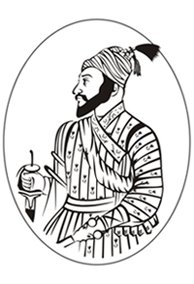Samartha Swami Ramdas has a special place in the history of Maharashtra. He represented in a way the vigorous aspect of Hinduism, its Jayishnu rupa. Ramdas was an ardent devotee of Lord Ram and Maruti (Hanuman). There is an account in Mahipati's Santavijaya, which describes how the image of Panduranga changed to one holding a bow and arrow (Rama). The saints saw it with their own eyes and said "You are the avatar of Maruti come to save the world", they said to Ramdas. He is one of the five saints, others being Dhyanadeva, Namadev, Eknath and Tukaram, who, as Abbott says, have contributed most to the religious life of Maharashtra.
Both Samartha Swami Ramdas and Shivaji made Maharashtra their main field of activity for over thirty years. Swami Ramdas established a chain of monasteries throughout the land where physical education was imparted with special emphasis on building bodily strength and character. The presiding deity in these Mathas was God Hanuman who symbolizes wisdom, strength, patience, fearlessness, vigour, sincerity, ready wit and alertness of mind, and Ram, the Maryada Purshottam, is embodiment of all imaginable virtues dear to a Hindu heart.
In Swami Ramdas, Shivaji found a sadguru and felt great spiritual solace in his company. Swami Ramdas' exposition of Rajdharma and Kshatradharma in his upadesa to Shivaji is well reflected in latter's State policies and in his war against Aurangzeb. The destruction of Ravana, the enemy of Gods, and establishment of Ramrajya and thus saving the dharma from the morass of wickedness and deceit, at once brought to mind the hostility of Aurangzeb towards the Gods and Goddesses of the people and his oppressive and unjust rule and Shivaji's fight against him without caring for the results.
Guru Ramdas was a witness of the destruction of temples and religious places and while he blessed Shivaji's efforts to roll back the Mughal tide, he himself led the task of creating an awakening, specially in the rural Maharashtra, by building temples dedicated to Shri Ram, Sita, Lakshmana and Maruti or Hanuman with the help of local villagers, and by establishing a number of monasteries which became radiating points of his preaching and philosophy. After the capture of Satara in 1673 A.D., on Shivaji's request, Ramdas made his abode on the neighbouring hill fort of Parli or Sajjangarh. Here he passed away in 1681, shortly after Shivaji's death. His inspiring teachings and ideas are enshrined in his abhangas, Bhavartha Ramayana, Dasbodha and other works.
The next painting shows Samratha Swami Ramdas installing a large idol of Maruti (Hanuman) in a temple. Shivaji, along with one of his queens, is standing nearby, observing the ceremony.
Both Samartha Swami Ramdas and Shivaji made Maharashtra their main field of activity for over thirty years. Swami Ramdas established a chain of monasteries throughout the land where physical education was imparted with special emphasis on building bodily strength and character. The presiding deity in these Mathas was God Hanuman who symbolizes wisdom, strength, patience, fearlessness, vigour, sincerity, ready wit and alertness of mind, and Ram, the Maryada Purshottam, is embodiment of all imaginable virtues dear to a Hindu heart.
In Swami Ramdas, Shivaji found a sadguru and felt great spiritual solace in his company. Swami Ramdas' exposition of Rajdharma and Kshatradharma in his upadesa to Shivaji is well reflected in latter's State policies and in his war against Aurangzeb. The destruction of Ravana, the enemy of Gods, and establishment of Ramrajya and thus saving the dharma from the morass of wickedness and deceit, at once brought to mind the hostility of Aurangzeb towards the Gods and Goddesses of the people and his oppressive and unjust rule and Shivaji's fight against him without caring for the results.
Guru Ramdas was a witness of the destruction of temples and religious places and while he blessed Shivaji's efforts to roll back the Mughal tide, he himself led the task of creating an awakening, specially in the rural Maharashtra, by building temples dedicated to Shri Ram, Sita, Lakshmana and Maruti or Hanuman with the help of local villagers, and by establishing a number of monasteries which became radiating points of his preaching and philosophy. After the capture of Satara in 1673 A.D., on Shivaji's request, Ramdas made his abode on the neighbouring hill fort of Parli or Sajjangarh. Here he passed away in 1681, shortly after Shivaji's death. His inspiring teachings and ideas are enshrined in his abhangas, Bhavartha Ramayana, Dasbodha and other works.
The next painting shows Samratha Swami Ramdas installing a large idol of Maruti (Hanuman) in a temple. Shivaji, along with one of his queens, is standing nearby, observing the ceremony.

